The Skerries is a well known sandbank off the coast of South Devon (UK), which is well known for its catches of plaice. I had been waiting for a long time to fish this location from the kayak. At the start of the week, it looked there might be a suitable weather window. I kept my eyes on the weather forecast and booked a day off work. Thursday saw me crawl out of bed at 5am. A quick look out of the window made my heart sink – really thick fog. Well, I had already decided to take a chance and make the 3 hour drive regardless.
Hallsands is a tricky location to find – its tucked away and easy to miss. It also has a fascinating history. In 1891 it had 37 houses, a pub called the London Inn, and a population of 159. On 26 January 1917, a combination of easterly gales and exceptionally high tides breached Hallsands’ defences, and by the end of that year only one house remained habitable. Many argued that the village was washed away becuase of the dredging which had taken place a few years earlier. In either case, it remains a slighly ghostly place to visit, especially when it is foggy !
I was the first one to arrive at the car park, but I was soon joined by two fellow kayak fishermen Mark and Tim. There was not a breath of wind, but the fog threatened to stop us from launching completely, let alone paddling out to the Skerries. We dragged the kayaks down to the edge of the shingle, and ummmed and ahhhed…
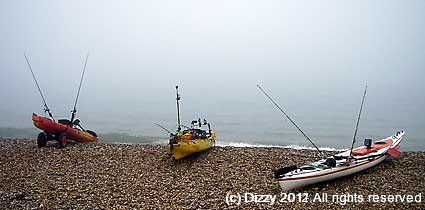
We decided to paddle out a short distance from the beach, and make a few drifts. My weapons of choice for this trip were 2 light rods – the Fladen Maxximus 10-20lb solid carbon rod (much lighter action than its line rating would suggest) and the Conoflex Kayak QT. These were teamed with a pair of Shimano Calcutta 400 baitcasters loaded with 12lb line. I was planning to try out a new plaice rig which Veal’s Steve Ace had been raving about; it seemed to go against everything I had heard about plaice rigs. Instead of using a long flowing trace, this rig used a relatively short wishbone style rig with size 1 Varivas aberdeens and a selection of bright beads and sequins. Mr. Ace knows his stuff, and if it was good enough for him, then it was good enough for me. So much so, that I left my rauto spoons at home.
We paddled out a short distance, and I switched on the side imaging sonar to try to locate some inshore sand banks.

After a few hundred yards, the fish finder started beeping – there was a shoal of fish under the kayak in midwater. One of the lads on the forum caught a mackerel at the start of the week, and I had a hunch that although it was only February, there might be the odd mackerel around, so luckily I had rigged up one of the rods with feathers. I quickly lowered it over the side, and “Bang” into the first mackerel of the year…
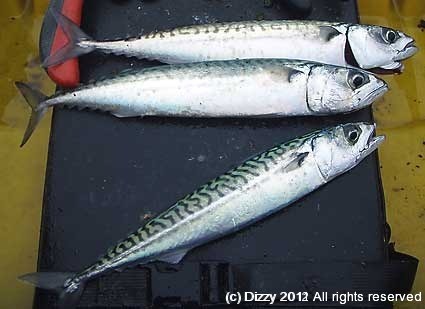
What a great start, and possibly the earliest I have ever had them. I then changed the feather rig and baited up both rods with lugworm, ragworm tipped with a long thin strip of squid. The side imaging had picked up a nicer looking sandbank, so I shouted to Tim and Mark and we started to drift along the edge of it.
Tim was first to catch…
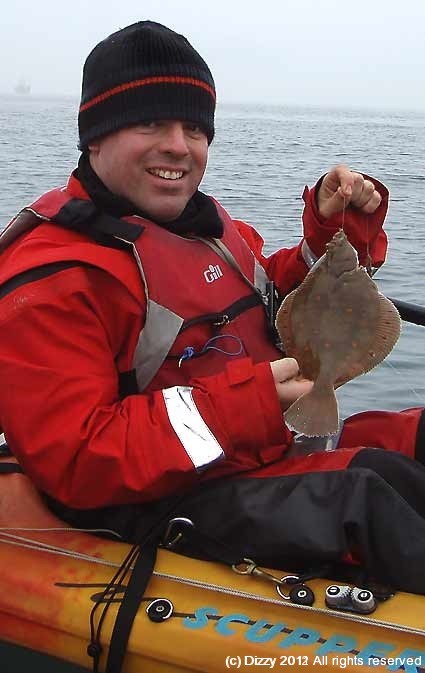
This was good news, at least it proved the plaice were inshore and feeding. It also meant that if we were to get out to the Skerries later in the day, then we would probably do well.
Then I managed to catch one…

The water was so clear, that you could see the fish fighting and flapping as it came towards the kayak. The bright spots really stuck out on such a dull day.
Then the fog started to lift a little, so we all agreed that we would paddle out to the Skerries in close formation keeping the land in view. I had also marked our departure point on the beach using the GPS, just in case the fog got worse.
A few minutes later and we were in 40 feet of clear calm water, on the edge of the skerries bank. There were lots of little gullies and ridges in the sand and these were picked out well by the side imaging… 
There were lots of sounds carrying across the water – in particular, the fog horn on Start Point and the sounds of a chainsaw from Hallsands could be heard as if they were only a few hundred meters away. But it also gave us a good bearing in the absence of visual cues.
The moment we started to drift (slowly) along the bank, we started to get bites. The bites seemed to increase when the drift speed was up’ed by putting in a couple of extra paddle strokes. I managed a dogfish, which I thought was a big plaice – much to the amusement of Mark ! Then we started to pick up the plaice thick and fast – the bites were strong, but we probably missed as many fish as we caught. We also put alot of the smaller fish back. Here are some of the highlights…
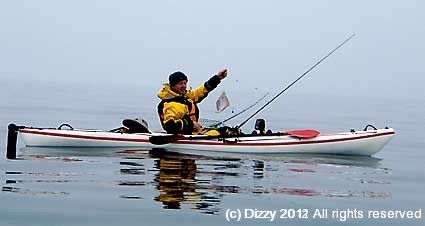

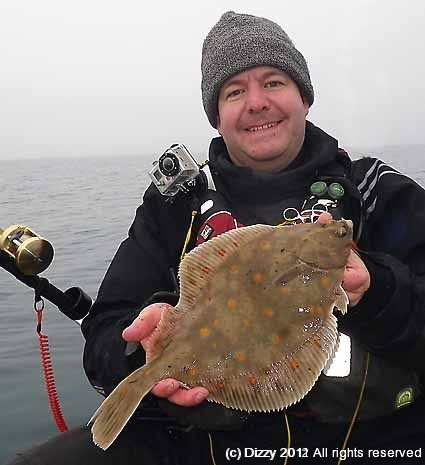
I also managed 2 plaice on one cast…
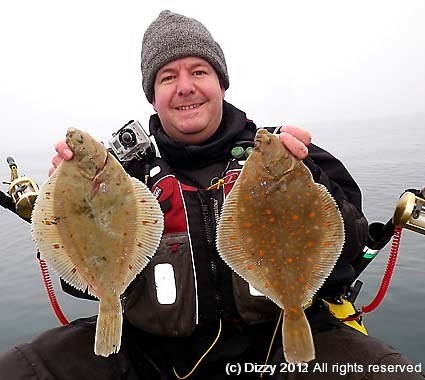
All too soon, it was time to return to the beach.
The obligatory catch photos…
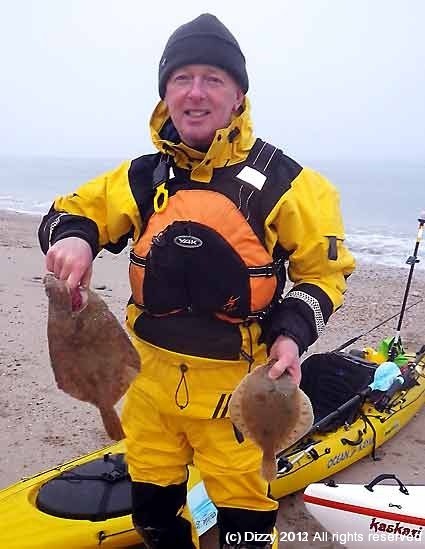

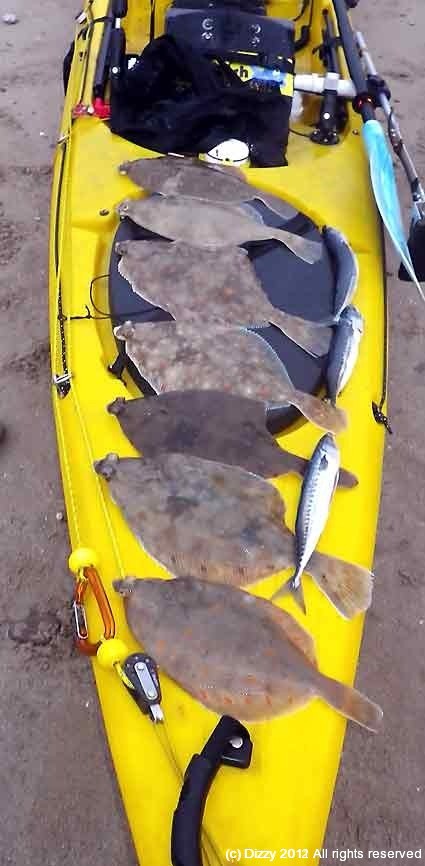
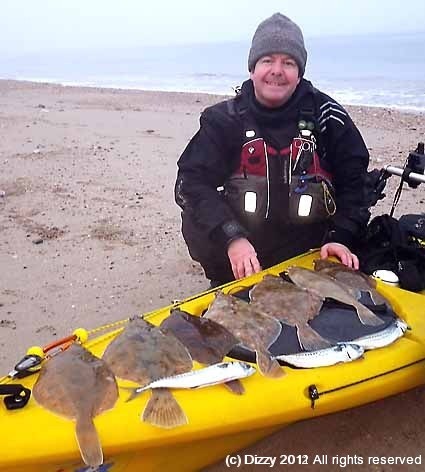
It was a great day with great company. Big thanks to Mark and Tim – hopefully we can do it all again soon.
HD Video of the days events…
[vsw id=”eDIRpiy-9WI” source=”youtube” width=”425″ height=”344″ autoplay=”no”]
*** Please be careful with this venue. North Hallsands beach is quite a steep shelving shingle beach which can make launching and exiting difficult when there is any surf, especially if the tide is up. Also be aware that there are some strong tide rips in the Start Point area, so be careful to stay away from Start Point if you are drifting the Skerries. I would also stick to small neap tides ***

Hi there, was just writing for abit of advice, ive seen ur article on the plaice fishing at skerries! I live local to hallsands and am new to kayak fishing but have only been lure fishing and wanted to do abit of bait fishing for plaice! I havnt got any fish finders or top of the range gear, just have a kayak and a rod, how do I know wherettt hHto fish? What baits are best? What tides best?what rigs? Just any general tips! Would be great to here back cheers!!
I am no expert – I have only fished there a few times; you don’t need fancy gear, but a GPS/fish finder is really useful to find the sand banks – there are a few around out from the beach (quite close in). I would stick to small neap tides and use lugworm/ragworm for bait. Small hooks (Size 1) and lots of coloured beads – the plaice seem to like them. I also tip my baits with a long thin strip of squid. Have you joined the forum on AnglersAfloat ? I would recomend it – you will get lots of good advice and maybe meet up with them.
Awesome, is there a fishfinder u would suggest that isnt to pricey?? ! Yeh ill have a look at anglers afloat!! Thanks for all ur advice!!
Hey Ian another great write up keep them coming
There are a few black and white fishfinders on the market for around £100 I have a fisheasy 140 which is ok I have used it for about 18 months and like it. I would love the setup that mr Dizzy has but there is no way I can afford it. I would also say that unless you have a legal marine VHF radio I would buy one of those first and take your license before spending money on a fishfinder. Safety first try you local adult education centre for a RYA short wave radio course I found they are cheaper than others and you get your license too.
Absolutely John – a marine portable VHF is a must (and you also need to go on an acredited VHF course in order to be able to use it). I would also put a decent waterproof handheld GPS higher up the list than the fish finder – safety is aramount with kayak fishing. Another fishfinder which is good for use on the kayak, and a sensible price is the Lowrance Elite 4x.